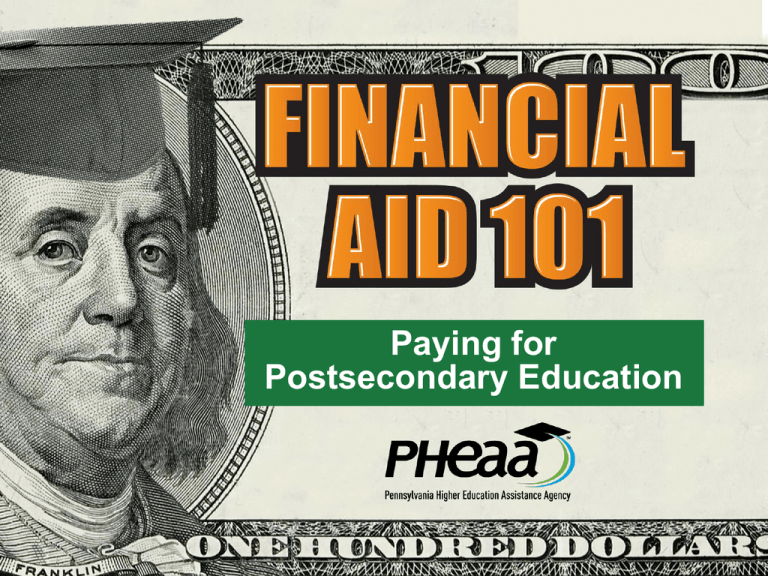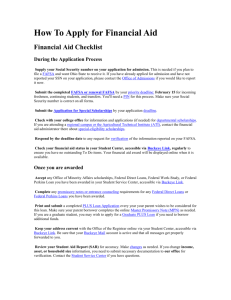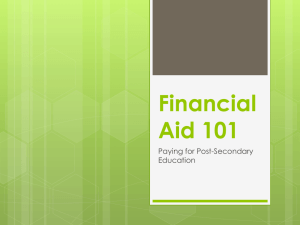What Is Financial Aid?
advertisement

Paying for Postsecondary Education Your Presenter Carol L. Handlan Higher Education Access Partner PA Higher Ed Assistance Agency chandlan@pheaa.org (717) 514-9038 • • • • What We’ll Cover Headlines & Trends Financial Aid Basics Scholarships Institutional Aid Also… • • • • Federal & State Aid Loans Forms Tips for Success A Recent Survey Says…… Financial Aid is “quite important” in the college search process BUT There is a great deal of confusion about processes, award amounts, and timing “2014 Rising Seniors’ Perceptions on Financial Aid,” produced by Ruffalocody Enrollment Management, in conjunction with Scannell & Kurz A Recent Survey Says…… Sources of Information on Financial Aid COLLEGE WEBSITES --- 40% HIGH SCHOOL COUNSELOR --- 33% PUBLIC INFORMATION WEBSITES --- 9% PARENTS, FRIENDS, AND/OR RELATIVES --- 8% FEDERAL INFORMATION WEBSITES --- 3% PRIVATE COLLEGE COUNSELOR --- 2% COLLEGE BOARD --- 1% CAMPUS VISITS AND TOURS --- 1% COLLEGE FAIRS --- 1% COLLEGE ADMISSION OFFICES --- 0.31% “2014 Rising Seniors’ Perceptions on Financial Aid,” produced by Ruffalocody Enrollment Management, in conjunction with Scannell & Kurz A Recent Survey Says…… ARE YOU GOING TO BORROW FOR YOUR UNDERGRADUATE DEGREE? PLANNING TO BORROW --- 48% I DON’T KNOW --- 43% NOT PLANNING TO BORROW --- 9% “2014 Rising Seniors’ Perceptions on Financial Aid,” produced by Ruffalocody Enrollment Management, in conjunction with Scannell & Kurz A Recent Survey Says…… WHEN DO YOU EXPECT TO RECEIVE A FINANCIAL AID OFFER FROM A COLLEGE? AT THE SAME TIME I AM OFFERED ADMISSION --- 27% I DON’T KNOW WHEN THAT HAPPENS --- 26% BEFORE I APPLY TO A SCHOOL --- 26% AFTER I FILE A FAFSA --- 21% “2014 Rising Seniors’ Perceptions on Financial Aid,” produced by Ruffalocody Enrollment Management, in conjunction with Scannell & Kurz Five Biggest Errors – High School Students • They don't job shadow and don't research or visit colleges. • They think college will be the same as high school. • They don’t think enough about their resume. • They aren't clear on who they are or what they want to be. • They don't do their research -- either before or after selecting a school. Do These Headlines Keep You Up At Night? • Student loan burden continues to grow • Paying For College - Are You and Your Student on the Road to Going Broke Or Into a Lot of Debt? • Is College worth the money? • U.S. Student-Loan Balances Increase 62% Between 2004 and 2012 • When Kids Come Back Home What Does It Mean? • Families will continue to struggle with college costs. • College still needs to be made more affordable. • To colleges and the government, “affordable” means making it easier to afford the payments. • To families, “affordable” means making it cost less. • Affordability can only be determined by the family. • Families must approach this from a consumer standpoint. Determining Affordability • Approach this as though you are not buying a school, you are buying an EDUCATION. • Look at sticker price (but don’t be scared away)!! Tuition costs in PA range from $2,500 to more than $40,000….PLUS room and board. Calculate out-of-pocket cost. • Understand that in higher education there is no direct correlation between cost and quality. • Be open minded and diverse in college searches. • Think in terms of yesterday’s money, today’s money, and tomorrow’s money. • Determine how much you can afford to borrow. • Set some parameters right up front. • Learn sources of aid • Know how to apply • File the FAFSA & SG app • Know your DEADLINES • Be a Smart Consumer These are your keys to financial aid success! What Is Financial Aid? Financial aid consists of funds provided to students and families to help pay for postsecondary educational expenses • Grants/Scholarships (free money) • Self-Help (work, savings, etc.) • Loans Basic Principles of Financial Aid • Paying is the joint responsibility of the student and parent(s), to the extent possible • Need-based financial aid subjected to federal formula to determine financial need • Not all families qualify for need-based aid. There is no guarantee that you will get any free money to pay for higher education Where Does the $$ Come From? Federal Government State Government School/Colleges Private Scholarship Sources: • • • • HS Counselors Clubs and organizations Employers Internet scholarship searches Did You Know? • The average student does not finish on time (transfers, change of major, etc.) • Every extra semester can significantly add to borrowing totals Scholarships Get the free money first! Scholarships • Scholarships are FREE MONEY! Scholarships are awarded by foundations, philanthropists, non-profit organizations, businesses and colleges to help students pay for college. • There are several free scholarship databases available online. With more than 1.5 million scholarships worth more than $3.4 billion. • The month of November is National Scholarship Month and is devoted to raising awareness of the need for scholarship support for postsecondary education. The 3 Categories of Scholarships • Postsecondary School Scholarships • Local and Regional Scholarships • National Scholarships Scholarship Search Tips • • • • • • Start Searching Early Use FREE Scholarship Search sites Don’t ignore scholarships with smaller award amounts Don’t miss deadlines Search for Scholarships every year Check corporate websites such as Target, Walmart, Kentucky Fried Chicken, as they all have scholarship programs and you don't have to work there to get them Create A Resume • • • • • • Activities and Hobbies Clubs Sports Community Service Religious Affiliation Academic Interests • Keep track of the hours spent in community service, working and on special projects. • Write down the dates you participated in various activities. Recognize Scholarship Scams 1. Application Fees • Even if the fee is minimal or “only to encourage serious students to apply” 2. “Guaranteed” Scholarships • No individual can honestly “guarantee” you’ll win free money 3. Solicitations • “You’ve been selected….” • “You are a finalist……” • Bona fide companies won’t ask for a check or credit card payment upfront 4. Official-looking Companies • The logo may look like the US Department of Education’s logo • The company may talk about “federal” or “national” awards 5. Seminars • Don’t get pressured into paying for services on the spot. (Ebony.com, quoting the Better Business Bureau) Scholarship Opportunities for Everyone • • • • • • • Scholarships for Average Students Variety of less competitive scholarships Community Service Scholarships Video contests Creativity Ethnicity Unusual scholarships » Based on Last Name » Seussvile: Oh, The Places You'll Go! College Scholarship • Patrick Kerr Skateboard Scholarship • Tupperware Home Parties Scholarship For more visit: http://www.finaid.org/scholarships/ fastweb.com • Fastweb.com is an excellent site to use for searching as it is a database that pulls specific scholarships for students based on their input. It also sends email alerts when a scholarship matches the student. • Fastweb.com is the largest, most accurate and most frequently updated scholarship database. www.fastweb.com Award Displacement vs. Stacking Ask your school’s financial aid office: “If I receive an outside scholarship, will you reduce the scholarship money you gave me by that amount or will you stack my new scholarship on top of what you gave me?” Financial Aid Programs Federal, State, and Schoolbased Federal Programs Pell Grant (2014-15 max award $5,730) * Campus-based aid – amounts determined by FAO • FSEOG………………… up to $4000 • Perkins loan….……….. up to $5500 • Federal work-study…… FAO determines For most programs, student must be enrolled at least half-time. * Goes to most financially needy students Other Federal Programs Please check out this web site to see all federal aid sources: http://studentaid.ed.gov/types#federal-aid PA State Grant • PA State Grant* • Full-time, in PA…...….up to $4,011 • Part time, in PA………1/2 of the FT award • Out of state: Up to $600 in DC, DE, MA, OH, RI, VT, WV • Amount determined in part by the cost of the school * Must be at least half-time to be eligible Other State Programs • State Work-Study - job related to major • Educational Assistance Grant (EAP) – National Guard • Chafee Education and Training Grant – administered by the Department of Public Welfare • Blind or Deaf Beneficiary Grant • Postsecondary Educational Gratuity Program (PEGP) • Partnerships for Access to Higher Education (PATH) • Pennsylvania Targeted Industry Program (PA –TIP) • Ready to Succeed Scholarship (RTSS) For details, see the PA Student Aid Guide, or visit www.pheaa.org Smart Borrowing Make every dollar count! Page 28 PA Student Aid Guide MySmartBorrowing.org This interactive tool gives you information you can use to make smart decisions about career choices and paying for college. MySmartBorrowing.org Borrowing for Higher Education • Always consider federal loans first. They have the best interest rates and repayment provisions. • Borrow in the following order: • Perkins Loan (5% fixed) – student • Direct Stafford Loan (currently 4.66% fixed) – student • Direct PLUS Loan (currently 7.21% fixed) – parent and graduate student • Alternative Loan (variable/fixed rates) – last resort Page 28 PA Student Aid Guide Be A Smart Borrower • Student debt is an increasing concern as more students graduate with staggering loan amounts. • Think about how you’ll repay your debt before you borrow. • Consider every potential free financial aid option before borrowing. • The federal government has made it very easy to borrow – this is good for access, but students need to be aware of the pitfalls of borrowing too much. • If you must borrow, only borrow what you need. Page 28 PA Student Aid Guide Smart Borrowing Tips Don’t borrow more to get your education than you can reasonably expect to make during your very first year in the workforce. (Keeps loan payment <12% of gross earnings.) Page 28 PA Student Aid Guide Smart Borrowing Tips Research job availability in your chosen field, before selecting your major. You won’t be able to repay your student loan if you aren’t gainfully employed. Research employment rates in your potential career field before making a final decision on your major. Page 28 PA Student Aid Guide Smart Borrowing Tips Research your expected salary in your future career, find an affordable school, and borrow realistically. There are many paths to the same degree. Research every option, including community colleges and commuting. Only attend a school you can reasonably afford. Only borrow what you absolutely need to attend. Page 28 PA Student Aid Guide Smart Borrowing Tips Consider all types of financial aid carefully. Grants and scholarships do not need to be repaid. Work-study provides part-time jobs for students. Loans must be repaid with interest. Page 28 PA Student Aid Guide Smart Borrowing Tips Educate yourself on the many loan options available before borrowing. No one loan option is perfect for every family. Conduct your own research on the various loan options. Decide on the best choice for your situation. Federal Loans If you need to borrow… Go with federal loans first! Federal Student Loans • Effective July 1, 2013, Federal Direct Loans now carry variable/fixed rates • “variable/fixed” means that the interest rate for new loans will be set annually, but the rate at the time of disbursement will remain fixed for the life of the loan • Rates on new loans reset on July 1st of each year Types of Federal Direct Loans Undergraduate Students • Subsidized • Unsubsidized Graduate students • Unsubsidized • PLUS Loan Parents • PLUS Loan Federal Direct Loan Program (for students) Subsidized = no interest charged to student while enrolled • Based on Financial Need • Interest will not be charged during the grace period, if the loan was first disbursed after June 30, 2014. Unsubsidized = interest accrues in school and grace • Any interest not paid during grace will be capitalized at repayment There is a 1.073% fee deducted from loan amount at disbursement. Interest Rates – Student Loans Undergraduate – Subsidized and Unsubsidized: • 4.66% for 2014-15 • Capped at 8.25% Graduate – Unsubsidized Only: • 6.21% for 2014-15 • Capped at 9.50% Parent Loan for Undergraduate Students (PLUS) PLUS Loans – Parent & GradPLUS • 7.21% for 2014-15 • Capped at 10.50 % • Up-front fee of 4.292% deducted at disbursement • May borrow up to full cost of education minus financial aid • Credit check is required on this loan Federal Direct PLUS Loan Repayment begins immediately - can defer repayment until 6 months after student graduates or drops below half-time enrollment. • If defer payment – encouraged to make interest payments • Standard Repayment is 10 years Direct Loan Borrowing Limits Additional Eligibility 1 Must be an independent student OR a dependent student whose parents were denied the PLUS Loan. 2 Student may need to contact the financial aid office to request the additional amount. Please note: “Year in College” is determined based on how many credits you have completed, not on the number of years you have attended school. Benefits of Paying Interest Loans must be repaid with interest. Paying now will reduce what is capitalized! • Interest accrues on your unsubsidized student loan and Federal PLUS Loan: – Every day, from the day the loan is disbursed until you make the last payment. – Even if your loan is not in repayment. • Interest accrues on your subsidized student loan: – Every day, from the day the repayment period starts until you make the last payment. Alternative/ Private Loans After considering all other aid sources Alternative/Private Education Loans • Nonfederal loans, made by a lender such as a bank, credit union, state agency, or a school. • Student borrows in his or her own name • Based on credit scoring and debt-to-income ratio • Repayment may be deferred until education completed • Fees, interest rates, loan amounts, and repayment provisions vary by lender and are generally higher than federal student loans • Co-signers usually required. Some loan products have a cosigner release option • Compare loans before making choice and read the fine print! FORMS No job is complete… Until the paperwork is done! The Free Application for Federal Student Aid (FAFSA) • The FAFSA (Free Application for Federal Student Aid) is a federal form used to determine student eligibility for the following: • Federal programs, such as Pell Grants, work-study, and student loans • State programs, such as Pennsylvania State Grant, and other special programs • School programs, such as need-based grants and scholarships Applying for Financial Aid Know what financial aid forms are required: • FAFSA (Free Application for Federal Student Aid) – federal aid, PA State Grant, college aid, and private scholarships • State Grant Form (SGF) required for first year students (and may be requested for subsequent years) • CSS Profile required by some postsecondary schools and scholarship organizations • Institutional financial aid forms Know Your Deadlines! Know all of your state and school/college deadlines and file the FAFSA by the earliest deadline. Federal Deadline - end of the award year - for 2015-2016, this would be June 30, 2016 PA State Grant deadlines – ◦ May 1, 2015 - If you plan to enroll in a degree program or a college transferable program at a junior college or other college or university (excludes community colleges) ◦ August 1, 2015 - If you plan to enroll in a community college; a business, trade, or technical school; a hospital school of nursing; or a 2-year program that is not transferable to another institution Know School Deadlines FAFSA Complete the FAFSA as soon as possible after January 1 of the year for which the student is seeking financial aid. Two ways to complete the FAFSA: • Online at www.fafsa.gov (highly recommended) - safe, secure, fast, skip logic, built-in edits - complete FAFSA on the Web Worksheet - print the confirmation page when finished • Paper FAFSA – call 1-800-433-3243 IRS Data Retrieval Tool (DRT) The IRS Data Retrieval Tool allows students and parents to access IRS tax return information needed to complete the FAFSA. Students and parents may transfer the data directly into their FAFSA. • IRS Data is available: » After 2 weeks of electronically filing federal tax return » After 8 weeks of filing a paper federal tax return If use estimated income to complete FAFSA, can go back once taxes are filed and use IRS Data Retrieval Tool. FAFSA Completion Tips • Can use estimated income to complete – once taxes completed MUST go back and update FAFSA • Answer all income questions • Carefully review untaxed income questions • Review asset questions before completing them • 529 Plans must be reported as parent assets • Assets do NOT include home, retirement, or insurance • Do not report a business if it employs less than 100 • Do not report a farm if you live on the farm • Some people can skip asset questions • Online Help available on the Form Who Is Independent? • • • • • 24 or older on Jan 1st of award year Veteran (includes active duty personnel) Working on graduate level degree Emancipated minor in legal guardianship Orphan, in foster care, or ward of the court at anytime when student was age 13 or older • Have legal dependents other than spouse • Student deemed homeless by proper authority (PA State Grant status can be different) Whose Information Goes on the FAFSA? • Divorced or separated parents (the parent the student lived with the most over the past 12 months. If equal, then the parent who provided more than 50% of student’s financial support) • Stepparents - yes • Adoptive parents - yes • Foster parents - no • Legal guardians - no • Anyone else the student is living with - no Special Circumstances • Recent death or disability • Reduced income • Recent Separation or Divorce Contact the school and ask for a special consideration AND Contact State Grant Division at PHEAA Signing the FAFSA Online • Student and parent sign electronically with a Personal Identification Number (PIN) • Apply for PIN at www.pin.ed.gov prior to January 1, or apply for a PIN when completing the FAFSA • Create your own PIN or have one assigned • Do not lose it. Write it down and store in a safe place • Can use for future FAFSA filing and parent can use for other children FAFSAs • Use to sign Stafford Loan application and Parent PLUS loan application • Can request a duplicate PIN, if necessary Apply for PA State Grant from FAFSA Confirmation Page Online PA State Grant App • Students who click on the link will be automatically moved to the PA State Grant Form and will be presented with the additional questions needed to determine State Grant eligibility which includes such items as enrollment status, value of PA 529 College Savings Program, program of study, and employment status. • Printing , signing, and mailing in the State Grant confirmation page is the last step in the process. PHEAA is working on an electronic signature capability but that is not available at this time. • Students will be able to view their status on Account Access available at pheaa.org about three days after completing the FOTW. Forms are filed! Now what?!? Determining Need-Based Eligibility • Student submits FAFSA • Family undergoes need analysis • Expected Family Contribution (EFC) is determined based on: - Parent income and assets - Student income and assets - Family size - Number of children in college - Age of the older parent This is NOT necessarily the amount you will pay each year! Expected Family Contribution (EFC) • The EFC is a number derived from a federal formula which considers a family’s income, assets, and other factors • In theory, the EFC is the amount a family can reasonably be expected to pay toward college expenses each year • In reality, it is not the amount a family is required to pay and it rarely is the amount a family actually pays. How Is The EFC Calculated? • Parent contribution + student contribution = EFC • Bulk of EFC comes from income • Home, personal property, qualified retirement funds, and value of life insurance excluded from assets • Asset protection allowance (based on age of older parent, or the parent if single parent household) • Parent asset contribution usually = roughly 6% • Student income contribution = 50% of amount over $6,310 • Student asset contribution = 20% of assets • Parent contribution divided by number of children in college at the same time What Happens Next? • Student Aid Report or Acknowledgment sent to student (review and make necessary corrections) • Information is sent to PHEAA. Student must complete State Grant Form (SGF). Can link to this directly from the FAFSA. • Account Access (PHEAA) - create an account at www.pheaa.org to view PA State Grant • Information is sent to schools/colleges. Send to all schools being considered. What School Costs Are Considered? • School costs include: » » » » » » Tuition and fees Room and board Books and supplies Transportation Miscellaneous living expenses Child care, if necessary You can receive financial aid up to the Total of the school regardless of your EFC! Calculating Financial Need Schools/colleges receive financial aid information and calculate financial need School cost……………………. $26,000 EFC…………………………………. - 3,000 Financial need………………..$23,000 Financial Aid Office (FAO) “packages” student based on financial need and available funding (varies from school to school). Financial aid award letter sent to student. Packaging Example Cost EFC Need $15,000 $ 3,000 $12,000 $25,000 $ 3,000 $22,000 $45,000 $ 3,000 $42,000 Loans Work Total Aid $ 6,000 $ 5,500 $ 0 $11,500 $ 8,000 $ 7,000 $ 2,000 $17,000 $18,000 $ 8,000 $ 3,000 $29,000 Gap (Cost – Aid) $ 3,500 $ 8,000 $16,000 $ 9,000 $ 17,000 $27,000 Free Money Actual Cont. (Cost – Free Money) Financial Aid Award Letter • Official notification from school about financial aid, terms, and conditions. • Lists the type and amount of each award to be received • Describes what must be done to accept or reject any award. • Discloses students rights, responsibilities, and academic requirements. Reviewing the Financial Aid Package After reviewing their packages, students should be sure they know and understand the following: • How much of the financial aid is free money? • Which awards are based on need, and which are based on merit? • Are there any conditions on the free money; in particular, is there a GPA requirement? • Will awards change from year to year? • Will institutional awards increase as tuition increases? • Will loans be needed? If so, how much? How to Cover the Actual Family Contribution • • • • • • • • • Savings – Family 529 Plans – Family Scholarships – Various Sources Grants – Federal and State Tuition Payment Plans – School Federal Student Loans – Department of Education Institutional Loans – School Private Education Loans – Bank Home Equity Loans – Bank How Much Should I Borrow? 1. Estimate your full cost of school 2. Borrow only what you need 3. Research your earning potential 4. Think long term 5. Keep a healthy mindset about debt Tips & Strategies Success is in sight! Reduce the Need for Financial Aid • Graduate on Time 4 year for Bachelors Degree / 2 year Associates Degree • Research and find the right school and major Minimize transfer and change of major • Earn college credits while in high school through AP courses, Vo-Tech, and dual enrollment • Consider options for cutting costs (commute, take summer classes, buy used books, make smart meal plan choices • 2 + 2 Strategy (2 years at a Community College then transfer credits to a 4 year school) • 3 + 2 (Master’s Degree) Beware of the 5-Year Plan Things like double majors, study abroad, internships, and athletics can enhance the educational experience and improve marketability. But it comes at a price: • • • • • Total cost just increased by 25%. The fifth year likely costs 20% more than the 1st year did. Loss of institutional funds if they only allow for four years. Loss of PA State Grant if all four years have been received. Reduction in student borrowing capacity if maximum loans received in the first four years (only $4,000 left). • Talk it over and plan ahead! Final Thoughts Before we call it a wrap! Wrap-Up • • • • • • • • • Narrow down career choices Research and apply to several schools Work hard on scholarship search Don’t fear the FAFSA (do the State Grant app, too) Release your info to several schools Compare estimated financial aid award letters Make the tough choices Think of the future Finish on time Be A Smart Consumer Do your Research… • What is the Net Price that you will pay? Use the Net Price Calculator at schools student is interested in attending to get an estimate of your “net price” to attend. Net Price calculator available on each school’s website. • What is the graduation rate? • What is the average debt of graduates? • What is the repayment rate and default rate of the school’s borrowers? • What is the employment outcome for recent graduates? What You Can Be Doing Now • Student and parent apply for a PIN at www.pin.ed.gov • Visit websites with free information about college, financial aid and careers • Explore scholarship opportunities – locally, regionally and nationally • Use Net Price Calculator at schools interested in attending to get an estimate of your “net price” to attend. Net Price calculator available on each school’s website. • Use the FAFSA4caster – to estimate EFC and eligibility for federal financial aid • Free online tool, available at www.fafsa4caster.ed.gov Resources • • • • • • • • • pheaa.org EducationPlanner.org & MySmartBorrowing.org Youcandealwithit.com Myfedloan.org PHEAA toll free: 1-800-692-7392 Federal Student Aid Info Center – 1-800-433-3243 www.fafsa.gov www.studentaid.gov – general financial aid info www.studentloans.gov – information on federal loans Contact Information CAROL HANDLAN chandlan@pheaa.org 717-514-9038 QUESTIONS?






